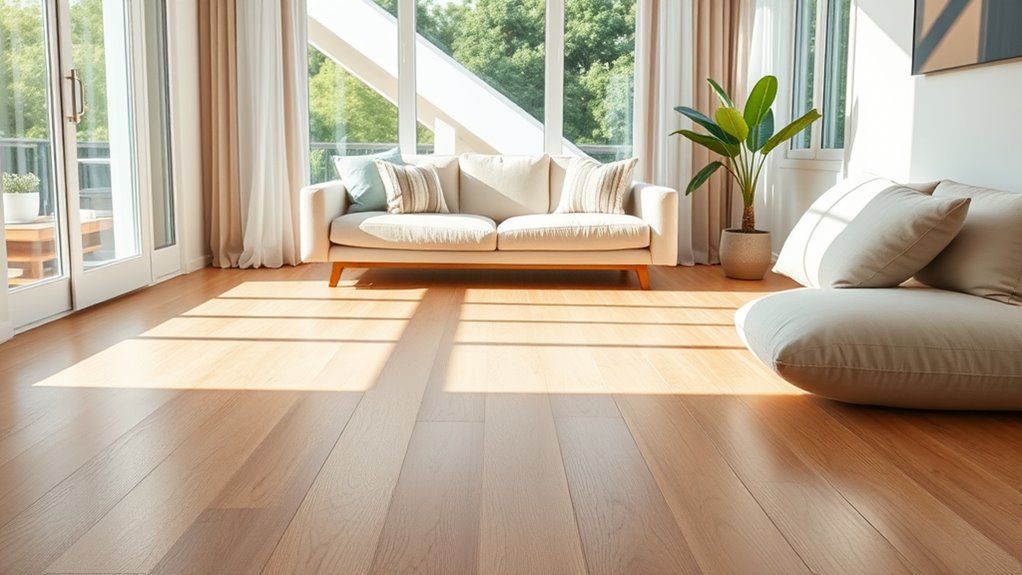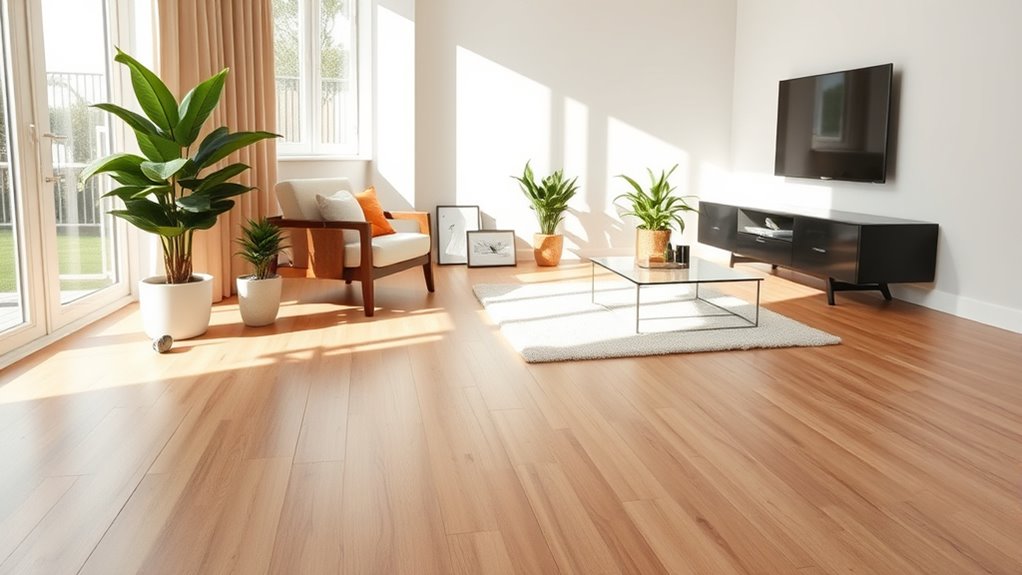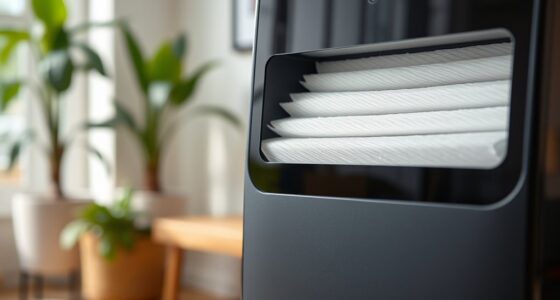Switching to low-VOC flooring helps improve your indoor air quality by reducing harmful chemical emissions that can cause headaches, respiratory issues, and long-term health problems. It minimizes lingering odors and lowers your exposure to toxic fumes during and after installation, making your home safer for children and pets. Plus, it supports a healthier lifestyle and aligns with indoor air standards. Keep exploring to discover even more ways low-VOC flooring benefits your health.
Key Takeaways
- Low-VOC flooring reduces indoor chemical emissions, leading to improved air quality and fewer respiratory irritants.
- Switching minimizes long-term VOC release, decreasing health risks like headaches and dizziness over time.
- It eliminates strong odors during and after installation, creating a more comfortable, odor-free environment.
- Low-VOC options lower exposure to toxic fumes, supporting better respiratory health for vulnerable individuals.
- Choosing low-VOC flooring aligns with health standards, promoting a safer, healthier living space overall.

Choosing low-VOC flooring not only enhances your home’s appearance but also offers surprising health benefits that often go unnoticed. One of the most significant advantages is improving indoor air quality. Traditional flooring materials can emit high levels of volatile organic compounds (VOCs), which are chemicals released into the air over time. These emissions can linger long after installation, continuously affecting the air you breathe. When you opt for low-VOC flooring, you reduce the amount of chemical emissions, leading to cleaner, fresher indoor air. This is especially important if anyone in your household has allergies, asthma, or other respiratory issues, as it minimizes triggers that can exacerbate these conditions. Better indoor air quality means you and your loved ones can enjoy a healthier environment without the constant worry of chemical vapors permeating your living space.
Chemical emissions from conventional flooring are not just a short-term concern; they can persist for years, gradually degrading the air quality inside your home. This ongoing release of VOCs can cause headaches, dizziness, eye irritation, and even long-term health problems with prolonged exposure. By choosing low-VOC flooring, you actively reduce the amount of harmful chemicals released into your environment. This decision can have a profound effect on your overall well-being, particularly in spaces where you spend most of your time, like bedrooms and living rooms. You’ll notice that your indoor environment feels fresher and less chemical-laden, making your home a more comfortable and inviting place.
Another benefit of low-VOC flooring is that it minimizes your exposure to toxic fumes during and after installation. Traditional flooring materials often release a strong odor and high VOC levels that can linger for days or weeks. Low-VOC options typically emit little to no noticeable smell, allowing you to settle into your home sooner and with less concern about breathing in dangerous fumes. This is especially valuable if you’re sensitive to smells or have children and pets, who are more vulnerable to chemical exposure. In the long run, choosing low-VOC flooring supports a healthier lifestyle by creating an environment where chemical emissions are kept to a minimum, reducing your risk of respiratory issues and other health complications. Additionally, selecting low-VOC materials aligns with indoor air quality standards and best practices for healthier living spaces.
Research shows that VOC emissions from flooring materials can also contribute to the development of respiratory problems over time, emphasizing the importance of selecting healthier options.
Frequently Asked Questions
How Do Low-Voc Floors Affect Indoor Air Quality Long-Term?
Switching to low-VOC floors considerably improves your indoor air quality over the long term. By reducing the amount of volatile organic compounds released, you create a healthier environment that minimizes respiratory issues and allergens. This air quality improvement supports your long-term health by lowering exposure to harmful chemicals. Over time, you’ll notice better breathing, fewer allergies, and a more comfortable living space, making low-VOC flooring a smart, health-conscious choice.
Are Low-Voc Flooring Options as Durable as Traditional Flooring?
You might worry that low-VOC flooring won’t hold up, but don’t throw the baby out with the bathwater. Many low-VOC options are surprisingly durable, matching traditional flooring in longevity with proper maintenance. While some durability concerns exist, these floors often require similar upkeep. With good care, you’ll find low-VOC flooring is a smart choice that doesn’t compromise on style or resilience, proving that good things come in eco-friendly packages.
What Are the Environmental Impacts of Producing Low-Voc Flooring?
When considering the environmental impacts of producing low-VOC flooring, you’ll find that it’s generally more eco-friendly due to sustainable manufacturing practices. Manufacturers often use eco-friendly materials and reduce emissions during production, which minimizes pollution. These sustainable methods help conserve resources and lower carbon footprints, making low-VOC flooring a responsible choice. By opting for such products, you support environmentally conscious manufacturing that benefits the planet and promotes healthier indoor environments.
Can Low-Voc Flooring Help Alleviate Allergy Symptoms?
When it comes to allergy symptoms, switching to low-VOC flooring can be a game-changer. You might think it’s just about looks, but it actually helps reduce airborne allergens that trigger respiratory issues. By lowering volatile organic compounds, you’re promoting better respiratory health and creating a healthier indoor environment. It’s not just a win-win; it’s a gust of fresh air, helping you breathe easier and feel more comfortable at home.
Is Low-Voc Flooring Suitable for Commercial or High-Traffic Areas?
You can definitely use low-VOC flooring in commercial or high-traffic areas, as it promotes indoor safety by reducing harmful emissions. It’s durable and designed to withstand heavy use, making it practical for such spaces. While cost considerations might be slightly higher initially, the long-term health benefits and lower maintenance costs often outweigh this. Overall, low-VOC flooring is a smart choice for creating a safer, healthier environment in busy settings.
Conclusion
Switching to low-VOC flooring is like planting a garden in your home’s heart—quietly nurturing your well-being beneath the surface. Just as a garden offers beauty and life, your choice in flooring creates a healthier sanctuary for you and your loved ones. Embrace this simple change, and watch your home blossom into a haven where every step you take is a step toward better health. Your home’s true beauty begins with the choices you make today.
Amina brings over a decade of journalism experience to her role as Editor-in-Chief. Under her leadership, Exquisite Post has flourished, maintaining the highest standards of integrity and excellence. Amina’s commitment to truth and her visionary approach guide the editorial team in producing impactful news stories that resonate with our audience.










